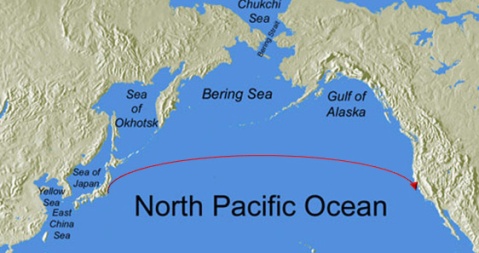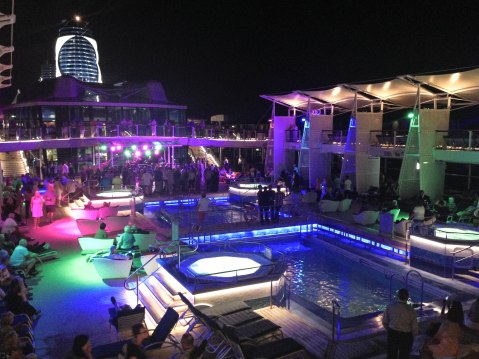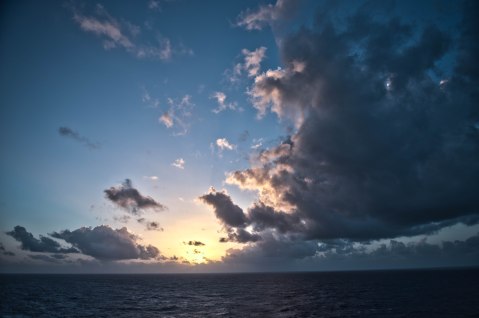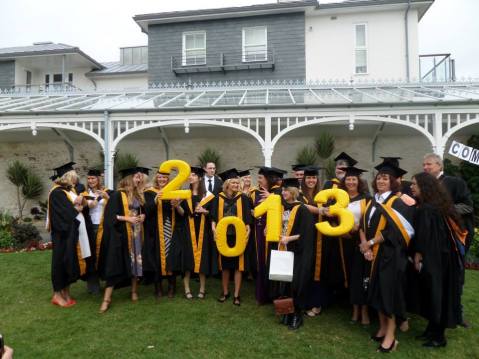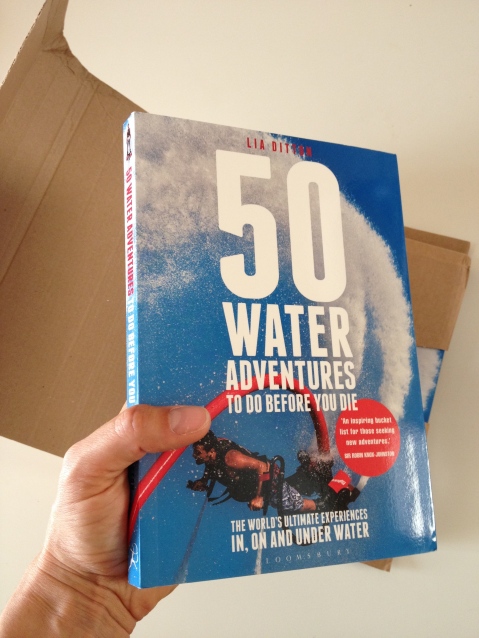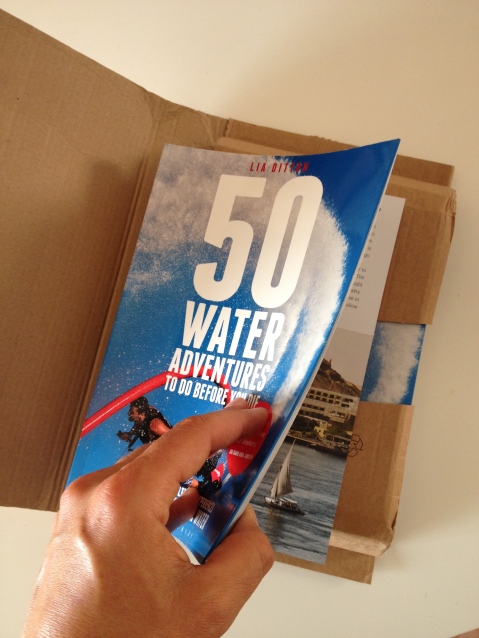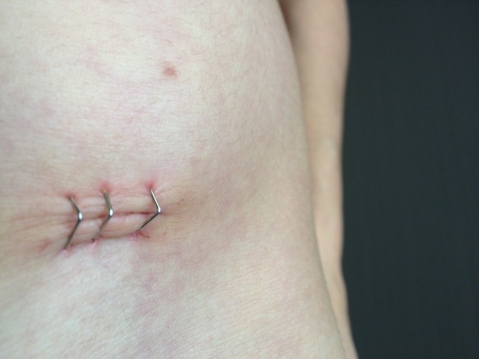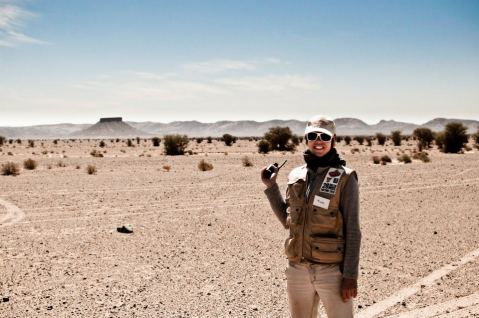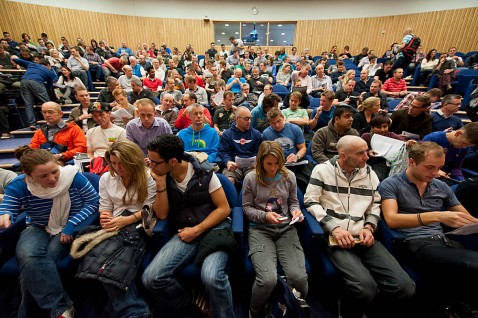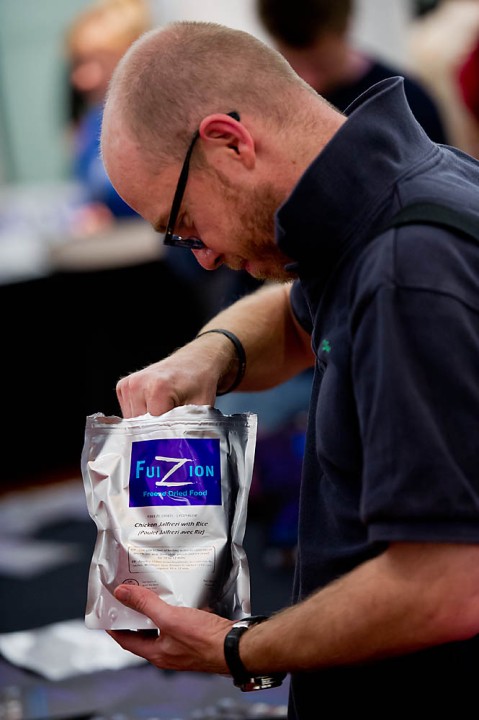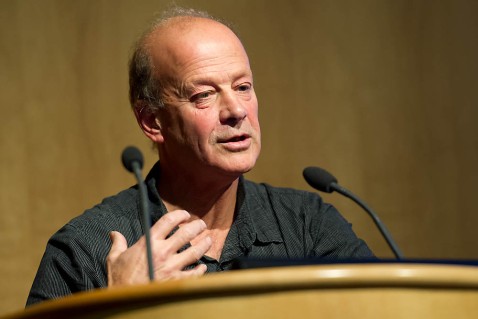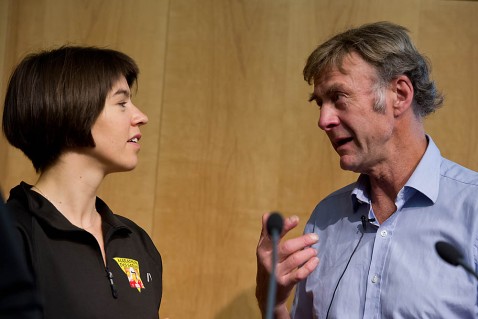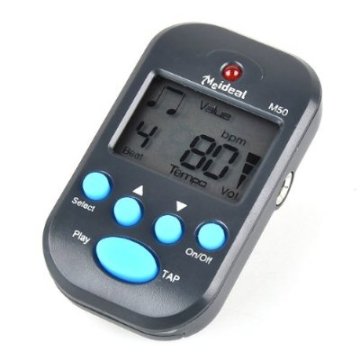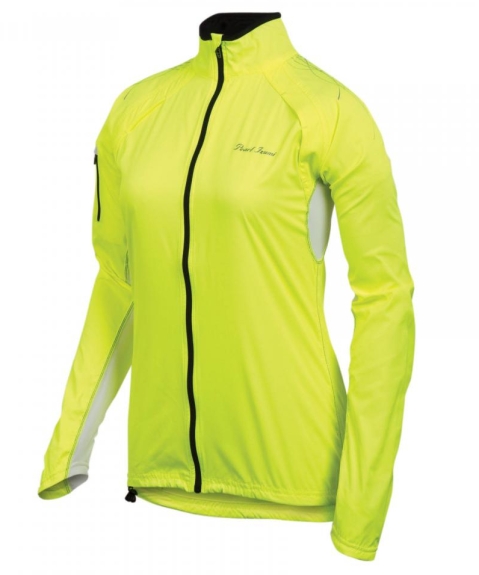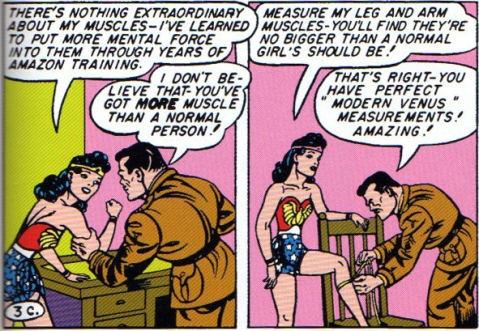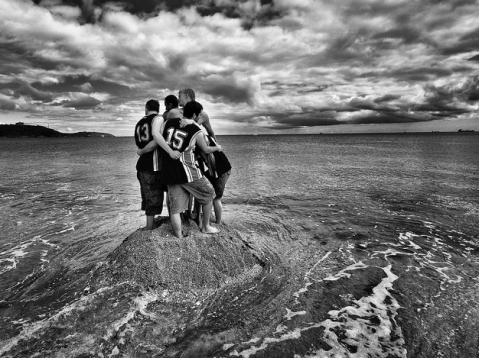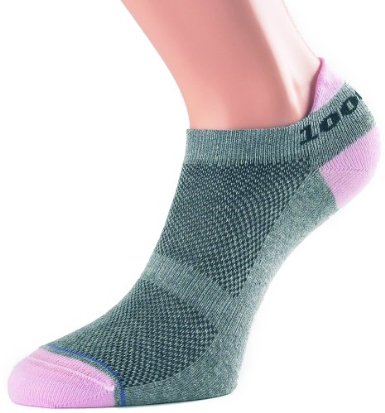Bottom to Top: New Zealand by boat
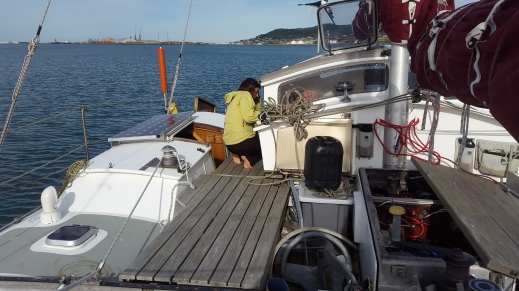
I was in the North Island of New Zealand when Cyclone Pam was wreaking havoc across the Pacific last month. For days, the people from Vanuatu working in New Zealand didn’t know if their families were still alive or if they had homes to return to. The news coverage of the disaster was extensive; the images of the devastation, sickening. I thought:
‘What can I do to help the Pacific Islanders?’
OceansWatch posted the answer on Facebook. A James Wharram-design Tiki 38 catamaran had just been loaned to OceansWatch for the sole purpose of coordinating aid relief and they needed a skipper to deliver her on the first leg of the boat’s journey.
On Monday, Laura Dekker, Gerard Ellmers and me will sail ‘Anam Cara’ from the very bottom to the very top of New Zealand.
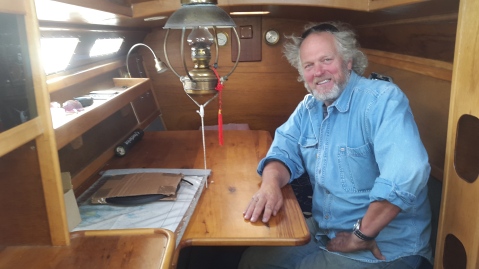
The owner (and builder) of ‘Anam Cara,’ Sytze Riemersma.
From Bluff to Whangarei is a distance of 1100 nautical miles. With winter fast upon us, we expect the voyage to be one of the coldest deliveries any of us have ever done. Our worst case scenario is an E, NE or SE wind direction making the coast a dangerous lee shore.
Prospective departure: 07:00am Monday 20 April NZ (GMT+12)
| FROM | TO | DISTANCE (nm) | TIME |
| Bluff | Dunedin | 147 | 1 day 13 hours |
| Dunedin | Christchurch | 199 | 2 days 2 hours |
| (Dunedin | Timaru) | 101 | 1 day 01 hour |
| (Timaru | Christchurch) | 131 | 1 day 09 hours |
| Christchurch | Wellington | 174 | 1 day 20 hours |
| Wellington | Napier | 221 | 2 days 07 hours |
| Napier | Gisborne | 87 | 22 hours |
| Gisborne | Tauranga | 197 | 2 days 01 hour |
| Tauranga | Auckland | 131 | 1 day 09 hours |
| Auckland | Whangarei | 83 | 21 hours |
Safe harbours between Bluff and Whangarei.
Podcast: Outside Health and Fitness
Here’s me chatting with Steve Stearns:
To subscribe to podcasts from Outside Health & Fitness, click here.
the year in which I nearly rowed the Pacific TWICE
About Samuel Beckett’s ‘Waiting for Godot’, the Irish Times wrote in 1956 –
‘a play in which nothing happens, that yet keeps audiences glued to their seats. What’s more, since the second act is a subtly different reprise of the first, Beckett has written a play in which nothing happens, twice.’
While I can’t say that my audience has exactly been glued to their seats, 2014 is certainly the year in which I nearly rowed the Pacific, twice!
When the Jersey Girls, an all-women team of four, stepped off their boat in Antigua in March 2010, they were pink with laughter from the good times they had shared. My crossing had been quicker, but my rowing partner and I never laughed. Strangers at the start, we parted strangers at the end.
Several months later I met Chris Martin who had rowed across the North Pacific Ocean with Mick Dawson. Their voyage took 189 days. A real long-haul of a row.
I became fascinated by the geography and started studying the Kuroshio current that runs off the east coast of Japan.
I began tracking the weather patterns and analysing the current pull through the underwater mountain range mid Pacific, the Hawaiian-Emperor Seamount Chain.
With good weather and lucky navigating, I am convinced that weeks if not months can be shaved off Chris and Mick’s 189 day record time. A bold statement I know.
Of the 18 known attempts to row the North Pacific, 15 have been unsuccessful. Solo rowers Gerard d’Aboville and Sarah Outen, whose crossings were deemed successful in 1991 and 2013 respectively, altered course to Washington State and Alaska to cut their journey’s short. Once winter sets into North America the ocean can be rough.
The camaraderie was the thing I missed while crossing the Atlantic, so I knew from the outset that I didn’t want to row the Pacific alone.
Sonya Baumstein and I connected online in October 2012. Immediately we joined forces with a view to rowing across the Pacific together, this year. Sonya did the hustling. I was the document editor in the background. Then we met in November 2013. The importance of spending time in person had been overlooked. Gut instinct said this partnership won’t work and we severed ties amicably.
When Chris Martin asked me to be head scrutineer of the Great Pacific Race (across the mid-Pacific from Monterey, California to Honolulu, Hawaii), the timing was right. Sonya and I thought we might be in the Pacific, but that hadn’t worked out. I left my foul weather gear at home on purpose.
I wasn’t going to be tempted.
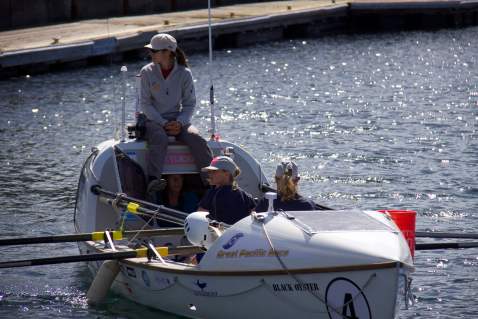
The pre-start period was an intense experience. A lot of sleepless nights. I worried a lot about the rowers and their campaigns in varying states of readiness. Day in day out and long days too, I worked with the teams to get their safety equipment in order.
By the end I was mentally in their boats, ready to row myself.
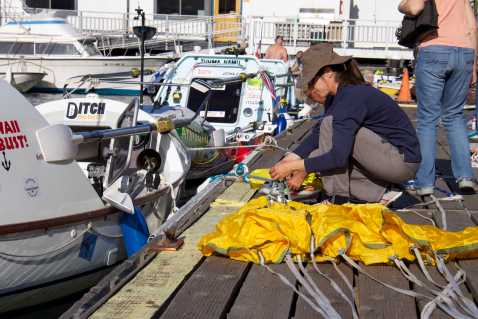
Nine hours after the start gun fired, a pairs boat returned. One of the ladies decided ocean rowing was not for her. Immediately I knew I would offer to step in, but I had a job to finish first. In a week’s time I would be free.
In the course of that week, two teams were rescued by Coast Guard helicopter. I found a weakness in the boat I was about to row, which was letting in water. This took two days to reinforce with fibreglass and sand. By this stage, the Coast Guard were putting pressure on Chris to deter further boats from leaving. We were on our own. We could row independently of the race, which I was fine with but my potential rowing partner was not.
Rarely do sailors drop out before an offshore race. Why is ocean rowing so different? The enormity of the challenge, the prospect of crossing a vast ocean and in a small vulnerable boat; the length of time at sea; the close proximity to your rowing partners, the physical grit of rowing for hours and hours and hours… in many ways, rowing the Atlantic eclipsed my sailing achievements. I remember when I arrived in Antigua and my dad and I stepped into a restaurant, where the first captain I ever worked with happened to be dining with his wife.
Did you just say you ROWED the Atlantic?
He pushed back his chair aghast.
So 2014 (not over yet) is the year in which nothing happened. I nearly rowed the Pacific Ocean, but didn’t, twice.
Third time lucky? Best sign up for my blog!
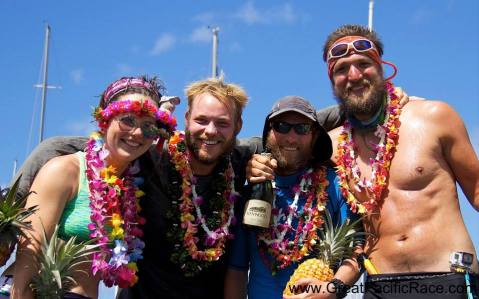
Congratulations to all the teams in the Great Pacific Race who rowed successfully into Honolulu this summer – Uniting Nations, Team Battleborn, Noman, Fat Chance Row, Boatylicious, Pacific Warriors, CC4 Pacific. And to those teams who readied boats, made it to the start line (a commendable feat in itself) and set off in good faith, only to be defeated – this time, by the elements.
Cruising

Just when I am in the final weeks of finishing my book, 50 Water Adventures To Do Before You Die, I receive a message from my speaking agent Tim Lavery:
Lia, interested in a westbound transatlantic cruise 1-16 November (2013)?
While I remain undecided about religion, I do believe in the God of Yachting.
Possible lump in left breast? God of Yachting puts stray container in front of boat’s bow and sends us limping towards the nearest port of call.
Break up from long-term relationship? God of Yachting sends me on Transpac sailing race from LA to Hawaii.
Desperately in need of holiday? God of Yachting sends me on a cruise…
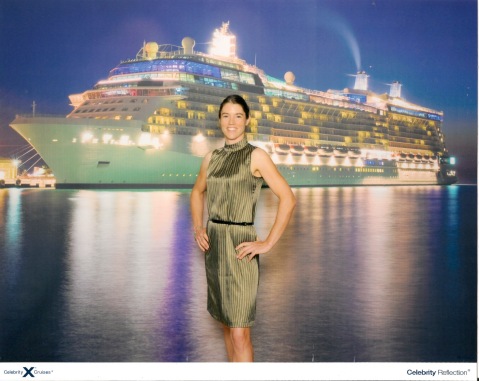 This is one of those fake overpriced photographs that you think you’ll never buy, until you see it and realise it would make the perfect Christmas gift for your parents.
This is one of those fake overpriced photographs that you think you’ll never buy, until you see it and realise it would make the perfect Christmas gift for your parents.
Before we set sail, I took a one-day course to finesse my public speaking. The course was run by my aunt and I can’t recommend it highly enough. Here’s Dilly talking about speaking.
When you think ‘cruise’ you probably think of this:
In reality, it was mostly a lot of this:
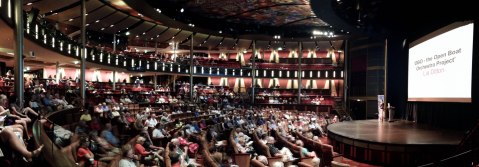 I was onboard to work after all!
I was onboard to work after all!
Leaving Rome for Miami…
- My first talk was in the 250 seater theatre with 50 standing.
- My second talk was in the main 1,300 seater, moved by popular demand (*gulp*)
This was the most delightful thing about speaking on a cruise ship. The audience of the first talk brought their friends along and so on. The expanding number looking out at me wasn’t as scary as I expected it to be either, because after the first talk there were 300 familiar faces, after the second talk there were 500-600…
And WOW what an audience! No one was in a hurry to go anywhere. Question time was often as long as my talks and boy was there a lot of laughter.
- I was only supposed to give 3 talks, but they asked me to do 2 more!
- The experience turned out to be a great stage-confidence builder.
Too bad my book was pending publication. I will just have to go on another cruise, preferably to Antarctica, which is one of the 50 Water Adventures To Do Before You Die!
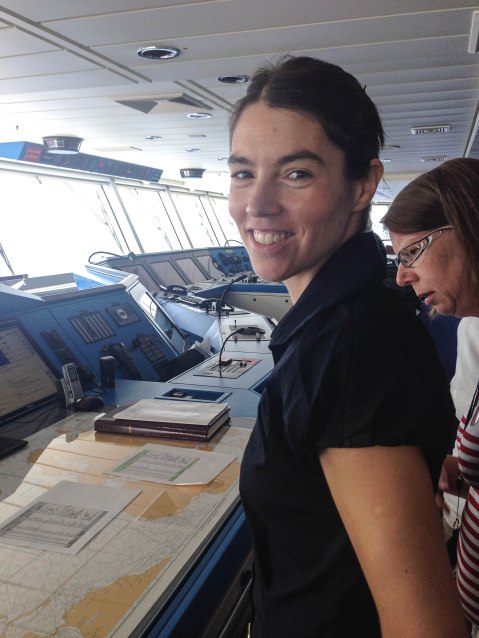 One of the guests kindly arranged for me to get a tour of the bridge. THANK YOU so much if it was you!
One of the guests kindly arranged for me to get a tour of the bridge. THANK YOU so much if it was you!
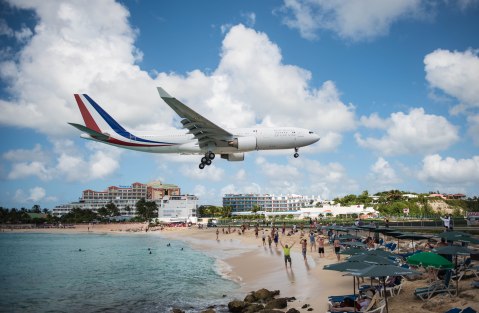 The cruise stopped off at Tenerife, the Caribbean islands of St. Martin and St. Kitts (a new one for me) before arriving in Miami.
The cruise stopped off at Tenerife, the Caribbean islands of St. Martin and St. Kitts (a new one for me) before arriving in Miami.
The image above shot by Alastair Maher is of the Air France Boeing 747 coming in to land breathtakingly close to Sunset Beach.
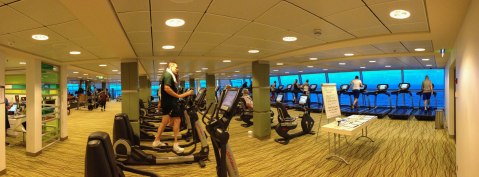 What I wasn’t expecting was for the gym to be packed all day long.
What I wasn’t expecting was for the gym to be packed all day long.
Most people walked rather than ran on the machines, which was very sensible, because when the boat rolled slowly to starboard I ran into the treadmill display and when the boat rolled slowly to port I nearly ran off the back of the rubber! The view from the treadmills will likely remain unrivalled…
I met a broad mix of wonderful people from all over the world.
It was pleasure to meet each and every one of you and I hope we get the chance to share a cruise again.
50 Water Adventures – update 2.0

I was bringing you up to speed from 2012 to 2014, before we got absorbed in the answer to the question of Life, the Universe and Everything…
The first big cheer of 2013 arrived with a 1st for my 2011-2012 MA in Professional Writing at Falmouth University.
The course was a combination of creative writing and writing for business, with the emphasis on writing for the market, writing to earn money and getting published.
As a testament to the course’s success, I couldn’t join my fellow graduates on graduation day because I was in the final throes of finishing my first book…
> That’s my hand holding the first proof! *Big grin* <
The book took 9 months to write, 2 years from conception to proof, and could not have come together without the 94 people who agreed to be interviewed and/or contributed images.
For the full list of acknowledgements, click the Kindle ‘Look Inside’ feature on Amazon.
Until September 11, I’m offering signed copies at 30% off RRP.
Pick your currency:
Pre-order sales are what make books instant bestsellers.
Make me dance!
PRE-ORDER TODAY!
Back in Cyberspace – update 1.0
You may have noticed that I have been away-from-my-blog, off Facebook – a thumbs-up giver and comment-maker rather than a poster of posts; a tweet-reader rather than a twitter’er.
In fact I have been rather anti-social about social media.
I have had my reasons. Thankfully those reasons no longer apply. Armed with my towel, I am ready to resume hitchhiking the galaxy!
If you have read Douglas Adams’ Hitchhiker’s Guide to the Galaxy, you will understand what this means. If you haven’t here’s a brilliant 28 minute podcast by the BBC R4 Bookclub.
To recap what I’ve been up to since 2012.
- I did not end up running the Marathon des Sables. Five months before the race, I went for a 4hr training run followed by a delicious black squid Paella (I haven’t been able to eat it since). Hours later, I was on my way to hospital in an ambulance writhing in pain – appendicitis.
I was barely well enough 4 months later to go to the desert to work as a ‘Commissaire du Bivouac’ for the race…
Highlights of the experience include –
- Flare demonstration: setting off a red parachute rocket flare (which we never get to play with on Survival At Sea courses), while standing on top of a Landrover in front of 1,500 people
- Joining famous French ultra-runner Laurence Klein and race director Patrick Bauer in his’ Ecureuil’ helicopter to fly over the course on what happened to be my birthday.
- Mapping out a runway with Giles “Avion” for the Cessna to land in a wadi (salt flat).
- Getting left behind.
One morning my driver stopped his truck and walked up a small jebel (hill) in search of mobile phone reception. He wanted to order bread for his family. As the convoy pulled away, my radio went out of range. I soaked up the silence of the desert and realised that what attracted me to the MdS was the appeal of SILENCE.
After working for the event for 2 years, the race became a job rather than a calling. I moved on, sadly without running the course.
During my stint with the MdS UK, I designed and wrote content for 3 websites, 1 Facebook account, 2 Twitter accounts and organised 2 conferences for 300 people.
The idea for first MdS UK EXPO arrived after I entered the race.
I need help! I thought to myself. I need professional help. I need advice from lots of professionals and I can’t be alone in thinking this.
The professionals were keen to help and the event sold out in advance!
For many runners, the freeze-dried lunch sponsored by Fuizion Freeze Dried Food, was their first freeze-dried meal EVER. (Fuizion is by far the market leader, so what a great way to start!)
I was thrilled when Dr. Mike Stroud, OBE agreed to speak.
And ecstatic when I also managed to book Sir Ranulph Fiennes.
Although to this day, I have no idea why Sir Ran held up this sign to the photographer after his talk, whether he wrote it himself or one of the attendees wrote it…
Perhaps the answer…
‘Yes…!’
‘Is…!’
‘Yes…!!!…?’
‘Forty-two,’ said Deep Thought, with infinite majesty and calm.
She’s Got Rhythm

It’s Saturday morning at 11.35am and I’m over half way through a spinning class. I’m riding flat out with 80% resistance when I become convinced,
I can’t keep up this pace.
Then the song changes. I’m not really aware of what the song is, only the beat. Dum-daahm-dum… I focus my mind on the beat. I begin pedaling to the beat – left leg up, right leg down etc.
After a few minutes I forget about the lactic acid build-up in my hamstrings. In fact, the lactic acid build-up seems to have disappeared. I am pedaling beyond my limit. My brain has been distracted by the beat.
This gives me an idea.
I go home and type metronome into Amazon.
To my surprise, Amazon suggests that if I like this mini clip-on metronome, then I might like the book Chi Running: A Revolutionary Approach to Effortless Injury-Free Running, which Amazon should know I already have. But I am intrigued to discover that I am not alone in my thinking. Phil (UK) in his product review, says:
I like to run with a metronome and earphone. I’ve tried metronome tracks on an mp3 player but this is better.
After flicking through my purchase options, I plump for the BestDealUK M50 on the grounds that it weighs a mere 19 g, only takes a 3 volt hearing aid battery and costs £4.99. Plus a compatible stereo earphone jack is available. I might want the ticktock in both ears later, you never know.
The good news is that if I can train to beats per minute now, then I might be able to metronome-stride my way across the Sahara. At least, that’s my latest plan. So, yes. I’ll come clean. I’ve been flagging in my training. Motivation is on the dip and I need a little pace-setter, if only in my head. Especially in my head.
Now She’s Got Rhythm, She’s got something I need…
All The Gear and No Idea?
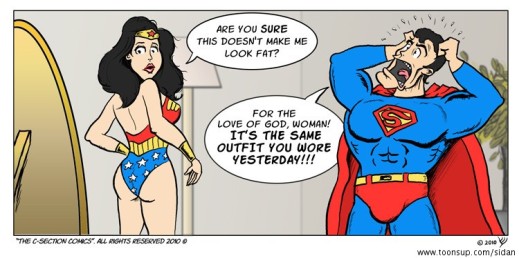
Naturally, the first thing I did when I decided to take up running seriously was go shopping.
Having heard that compression clothing was the latest thing, I ordered a pair of Under Armour Core X Coldgear Tight Running Pants to try. The words tight running pants (a.k.a tights) should have been my first clue and of course what looked like a delicate pink on screen turned out to be fluro pink. Oh well nevermind, I thought trying them on in the privacy of own my living room. They felt great and fitted like a glove.
My second purchase was a gorgeous wind-stopper jacket from Brian at RunTru.
Pearl Izumi in brand and extremely lightweight, the shell I chose was fluorescent yellow or screaming yellow as described on their website. Thus it became apparent on my first outing in my new gear, that I must have envisaged running in the dark, when nobody would see me.
I’ve always said that if I marry an American I’m going to do so in Vegas dressed as an alien – green face, friends wearing foil hats… now a pair of compression tights with fluro pink threading and a screaming yellow shell may be all that’s needed to complete the scene. In the meantime, I will continue to run around Falmouth, thankful that I am not quite the slowest runner in the world and that if people are commenting I’m not hanging about to hear it!
The good news about compression tights is that they wrap around my shins and calves, quadriceps and hamstrings and make my legs feel less like legs and more like leg machinery. This may sound very odd, which of course it is, but if you follow my logic – if they feel less like legs, then I can pretend that they’re not my legs! ‘Come on legs!’ I can say as if they are outside of my will – the pathetic will that obviously wants to slow down and preferably stop. This is all part of the training. My legs need to learn to transport my upper body around 6 times per week, so that when they stop they feel like they are intended to keep going, up dunes, down dunes…
Like an athlete, a long distance runner
On a track meet spring, fall, winter, summer
(chorus)
No alcohol, no weed
No cigarettes, no E’s
No milk, no cheese
No eggs, no meat
Just meditation and peace
Red lentils, chick peas
Good workout, good sleep
Mo’ sunshine, light breeze…
Finally I have started wearing a backpack, not intentionally mind you, but because the gym closes at 9pm. Strapped into my backpack I feel like a superhero with a jet pack. I feel invincible and fast. ‘Yes!’ I say to myself. ‘I can do anything.’ I swing my arms forward, left then right. Then I look down and my legs are moving impossibly slowly and I chuckle in comic despair. ‘How am I ever going to run across the Sahara?’
Years of Amazon training may be required…
She Blinded Me with Science!

Now that I am beginning to get serious about my entry in the Marathon des Sables 2013 and running 6 days per week (…as of last Friday), I have managed to acquire a 4-phase, 12 month training programme specifically geared towards the MdS! Carefully designed by Nic Jarvis, each phase of the programme is 12 weeks long and rather than the emphasis being on speed, the programme is governed by heart rate zones, MAP, MEP and SAP.
But the real je ne sais quoi of this programme, is that each day of the 6 in the running week corresponds to a percentage of the marathon that I will be running on-that-day in the Sahara.
Sounds good so far… but what the heck do MAP, MEP and SAP stand for? According to Ingo Logé (Exercise Physiologist Clinical Nutritionist, Chek Practitioner and the owner Of Fitness Forever Personal Training In Palm Desert, California…), who claims that a target heart rate zone can guide me to my “most energy-producing state;”
MAP = my Mostly Aerobic Pace (aerobic and fat burning.)
MEP = my Most Efficient Pace. “In this precise, precariously situated zone, you have the heightened awareness of a tightrope walker,” – Logé.
SAP = Speedy Anaerobic Pace “In this zone you feel noticeably challenged, in a state of greater stress and strain, with a sense of urgency and alarm!” (anaerobic sugar-burning.)
If, like me, you are struggling to believe that in heart-rate zone terms, the acronym SAP really does stand for, “Speedy Anaerobic Pace,” you can rest assured! I consulted ehow.com and an article appropriately titled, How to Run an Ultramarathon, and sure enough it does. I found further enlightenment on Chris’ Ultra Blog – thanks very much Chris!
So to work out your MAP, MEP and SAP…
180 – your age = MEP Upper Limit > 159 for me (call it 160)
MEP Upper Limit – 10 = MEP Lower Limit > 150
MEP L.L – 20 = MAP L.L > 130
MAP L.L + 20 = MAP U.L > 150
MEP U.L + 20 = SAP U.L > 180
SAP U.L – 20 = SAP L.L > 160
So, what about my poor body with all this pavement-pounding? Well, firstly I’m running off-road and along the beach as much as possible – which I really enjoy a) because it’s authentic training (It’s not called the Marathon of the Sands for nothing!) and b) because it’s beautiful when the tide is out and the waves are gently lapping the shingle. Aww…
However, as recommended by my pal Matt Judge, I have started taking a Glucosamine and Chondroitin supplement. Both substances can be found lurking in the Joint Care section of all good health-care stores and I have felt a remarkable difference to my knees. When I do squats they no longer snap, crackle and pop and when I’m out running, they don’t winge!
The US National Centre for Complementary and Alternative medicine did a study of the benefits of Glucosamine + Chondroitin and its intervention in the pain relief of osteoarthritis sufferers. Here comes the science:
Glucosamine and chondroitin sulfate are natural substances found in and around the cells of cartilage. Glucosamine is an amino sugar that the body produces and distributes in cartilage and other connective tissue, and chondroitin sulfate is a complex carbohydrate that helps cartilage retain water.
According to Wikipedia, Glucosamine is produced commercially by the hydrolysis of crustacean exoskeletons (or, less commonly by fermentation of a grain such as corn or wheat), whereas Chondroitin sulphate is extracted from cow or shark cartilage. Hmm. Still, Runners’ World is an advocate as are 79.8% of their surveyed runners! I managed to find it in liquid form along with aloe vera, thanks to Forever Freedom, who have:
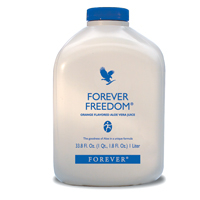 “…married the rich nutrients of stabilised aloe vera gel with glucosamine sulphate, chondroitin sulphate, methylsulphonylmethane (MSM), ascorbic acid (vitamin C) and tocopherol (vitamin E)…” in a “tremendous combination drink!”
“…married the rich nutrients of stabilised aloe vera gel with glucosamine sulphate, chondroitin sulphate, methylsulphonylmethane (MSM), ascorbic acid (vitamin C) and tocopherol (vitamin E)…” in a “tremendous combination drink!”
Second on the supplement list is (sustainable, Antarctic Ocean) Krill Oil, which I opted for over the standard Cod liver oil, simply because the capsules are half the size. Apparently, Krill Oil is twice as effective as Cod liver oil and has the best source of uncontaminated Omega-3 EPA & DHA, blah blah blah… I did mention that the capsules were smaller didn’t I? And finally I wash that all down with a few drops of Echinaforce in water, for a little immuno-boost.
After all that jargon, I will leave you with Thomas Dolby’s eighties hit, ‘She Blinded Me with Science!’
Now all I need is a heart rate monitor, so that I can jog to my MAP, MEP and SAP zones…
‘If you can’t fly, then run. If you can’t run, then walk. If you can’t walk, then crawl…

…but whatever you do, you have to keep moving forward,’ said Martin Luther King Jr. in his ‘I have a dream’ speech.
Not only do I too have a dream – the Marathon des Sables 2013, Luther King’s words couldn’t have been better advice this week as I struggled with a shin splint. I can’t fly and so was going running. When I felt ill-advised to run, I walked. When I had walked enough miles, I crawled home and iced up! Yes, I was warned and yes I probably ran too far too soon. Or was it too fast? Or did I just heal-strike one too many times?

Either way, I have now learnt that the cheapest (and arguably most effective) ice-pack can be found, not in the pharmacy but in the supermarket’s frozen veg section. The little Tesco’s near me had run out of frozen peas (students!), but had plenty of bags of frozen sweet-corn kernels and for less dollar! It was interesting to note that a tea-towel wrapped bag of corn also delivered a lower intensity cold for longer.
However, for shin splints, the website Sports Injury Info, recommends rubbing a home-frozen ‘ice cup’ directly onto the affected area, which looks intriguing. I will have to give it a whirl.
But maybe I just need to harden up –
What Martin Luther King didn’t say, Baz Luhrman has kindly added in Everybody’s Free (To Wear Sunscreen) – the song based on the poem by Mary Schmich. Here are the running-relevant lyrics:
Stretch.
Get plenty of calcium.
Be kind to your knees. You’ll miss them when they’re gone.
Enjoy your body. Use it every way you can. Don’t be afraid of it or of what other people think of it. It’s the greatest instrument you’ll ever own.
The race is long and, in the end, it’s only with yourself.
And on that note, I feel like playing a song from the band CAKE called The Distance, because when I run over 10k, I look down at my feet wheeling round and round and often think, ‘Those things beneath my waist. They’re not my legs. They’re doing their own thing.’ Perhaps this is the nirvana of running? Let’s hope so.
He’s going the distance.
He’s going for speed.
She’s all alone
In her time of need.
Because he’s racing and pacing and plotting the course,
He’s fighting and biting and riding on his horse,He’s going the distance…
While we’re talking about distance, I have to mention my new 1000 mile socks, bought from Brian at Run Tru in Truro!
Made of Tactel ® a polymer which is apparently ‘soft, supplely smooth, breathable and lightweight,’ the socks have cute descriptions – women’s ‘trainer liner’ and a ‘technical racing socklet!’ To the feet, well mine anyway, the socks feel like silk gloves, which in case you’ve never put a silk glove on your foot before, feels divine! Here comes the science:
The Tactel ® inner layer stays with the foot, wicking away moisture, whilst the outer moves with the shoe.
Sounds pretty clever to me, but wait for it – my favourite bit comes under the heading THE GUARANTEE.
Money back or replacement if, within one year from date of purchase, either you experience blisters or the socks wear out within 1000 miles, provided care instructions have been followed and socks are returned with original receipt.
So, firstly I worked out how many hours, days and weeks of running that would entail.
1000 miles/1609.344 km @ 10k/hr =
161 hours of running
@1hr day/7 days p.w
= 23 weeks or just under 6 months.
Now, here’s the more important question. Assuming I run everyday in the same pair of socks and wash them overnight over the course of 6 months (and keep the receipt!), how many washes do you think the ‘technical racing socklets’ will be able to handle?
Answers on a postcard please!
